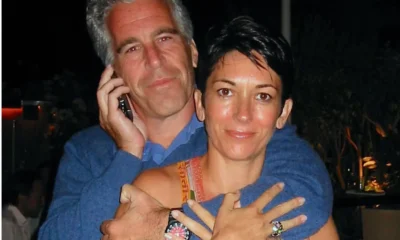Entertainment
Carl Weathers: Mourned, Remembered by Sylvester Stallone and Rocky Cast on February 3, 2024 at 11:40 am The Hollywood Gossip
As you may have heard by now, Carl Weathers is dead at the age of 76.
The veteran actor passed away “peacefully in his sleep” on February 1 according to family members, who released a statement on Friday that reads as follows:
“Carl was an exceptional human being who lived an extraordinary life. Through his contributions to film, television, the arts and sports, he has left an indelible mark and is recognized worldwide and across generations.
“He was a beloved brother, father, grandfather, partner, and friend.”
In this handout photo provided by NBCUniversal, Sylvester Stallone and Carl Weathers, who co-starred in the 1977 Golden Globe Award-winning film Rocky, present the Golden Globe for Best Motion Picture – Drama during the 74th Annual Golden Globe Awards. (Photo by Paul Drinkwater/NBCUniversal via Getty Images)
Weathers appeared in 75 movies and television shows throughout his impressive career.
He most recently starred in nine episodes of Disney’s The Mandalorian, and he was known for roles in such hit films as Predator, Happy Gilmore and Action Jackson.
But it was Weathers’ role as heavyweight boxing champion Apollo Creed in the Rocky that put this star on the acting map.
And for which he’ll likely be most remembered.
Carl Weathers presents the Montecito Award to Actor Sylvester Stallone at the Arlington Theater at the 31st Santa Barbara International Film Festival on February 9, 2016 in Santa Barbara, California. (Photo by Mark Davis/Getty Images for Santa Barbara International Film Festival)
The original Rocky was written by Sylvester Stallone, who selected Weathers for the role of Creed back in the mid 1970s… and who paid moving tribute to his friend this week.
“We lost a legend yesterday,” Stallone wrote in an Instagram statement, alongside an emotional video.
“My life was forever changed for the better the day I met Carl Weathers. Rest in power and keeping punching.”
In his video, Stallone said he “never could have accomplished what we did with Rocky without” Weathers, adding for all to see and hear:
“He was absolutely brilliant. His voice, his size, his power, his athletic ability, but more importantly, his heart, his soul. It’s a horrible loss.”
Carl Weathers attends the panel for âThe Mandalorianâ series at Star Wars Celebration in Anaheim, California on May 28, 2022. (Photo by Jesse Grant/Getty Images for Disney)
Elsewhere, Michael B. Jordan played Apollo’s son, Adonis “Donnie” Creed, in 2015’s sequel Creed, along with two follow-ups to this movie.
He also shared a tribute to the man who portrayed his on-screen father.
Via a story posted on his Instagram account Friday, the actor included a photo of Weathers with the caption, “We lost a Legend.”
Carl Weathers stands on the Las Vegas Raiders sideline before the team’s game against the Houston Texans at Allegiant Stadium on October 23, 2022 in Las Vegas, Nevada. The Raiders defeated the Texans 38-20. (Photo by Ethan Miller/Getty Images)
Finally, Rocky IV star Dolph Lundgren posted a statement about appearing opposite with Weathers in the 1985 film.
“I was saddened to hear the news this morning,” said the actor, who played boxer Ivan Drago.
“Along with the world, I will miss Carl. He was a great actor, a terrific athlete and a good friend. I cherish many special memories of Carl, both professionally and personally.
“Like Apollo Creed, he had that special charm that always brought a smile to your face.”
May Carl Weathers rest in peace.
Carl Weathers: Mourned, Remembered by Sylvester Stallone and Rocky Cast was originally published on The Hollywood Gossip.
[[{“value”:”Carl Weathers is dead at the age of 76. Here, those who knew the actor well and those who worked with him pay tribute to the star.
Carl Weathers: Mourned, Remembered by Sylvester Stallone and Rocky Cast was originally published on The Hollywood Gossip.”}]]
The Hollywood Gossip Read More
Entertainment
What We Can Learn Inside 50 Cent’s Explosive Diddy Documentary: 5 Reasons You Should Watch

50 Cent’s new Netflix docuseries about Sean “Diddy” Combs is more than a headline-grabbing exposé; it is a meticulous breakdown of how power, celebrity, and silence can collide in the entertainment industry.
Across its episodes, the series traces Diddy’s rise, the allegations that followed him for years, and the shocking footage and testimonies now forcing a wider cultural reckoning.

1. It Chronicles Diddy’s Rise and Fall – And How Power Warps Reality
The docuseries follows Combs from hitmaker and business icon to a figure facing serious criminal conviction and public disgrace, mapping out decades of influence, branding, and behind-the-scenes behavior. Watching that arc shows how money, fame, and industry relationships can shield someone from scrutiny and delay accountability, even as disturbing accusations accumulate.

2. Never-Before-Seen Footage Shows How Narratives Are Managed
Exclusive footage of Diddy in private settings and in the tense days around his legal troubles reveals how carefully celebrity narratives are shaped, even in crisis.
Viewers can learn to question polished statements and recognize that what looks spontaneous in public is often the result of strategy, damage control, and legal calculation.
3. Survivors’ Stories Highlight Patterns of Abuse and Silence
Interviews with alleged victims, former staff, and industry insiders describe patterns of control, fear, and emotional or physical harm that were long whispered about but rarely aired in this detail. Their stories underline how difficult it is to speak out against a powerful figure, teaching viewers why many survivors delay disclosure and why consistent patterns across multiple accounts matter.
4. 50 Cent’s Approach Shows Storytelling as a Tool for Accountability
As executive producer, 50 Cent uses his reputation and platform to push a project that leans into uncomfortable truths rather than protecting industry relationships. The series demonstrates how documentary storytelling can challenge established power structures, elevate marginalized voices, and pressure institutions to respond when traditional systems have failed.
5. The Cultural Backlash Reveals How Society Handles Celebrity Accountability
Reactions to the doc—ranging from people calling it necessary and brave to others dismissing it as a vendetta or smear campaign—expose how emotionally invested audiences can be in defending or condemning a famous figure. Watching that debate unfold helps viewers see how fandom, nostalgia, and bias influence who is believed, and why conversations about “cancel culture” often mask deeper questions about justice and who is considered too powerful to fall.
Entertainment
South Park’s Christmas Episode Delivers the Antichrist

A new Christmas-themed episode of South Park is scheduled to air with a central plot in which Satan is depicted as preparing for the birth of an Antichrist figure. The premise extends a season-long narrative arc that has involved Satan, Donald Trump, and apocalyptic rhetoric, positioning this holiday episode as a culmination of those storylines rather than a stand‑alone concept.
Episode premise and season context
According to published synopses and entertainment coverage, the episode frames the Antichrist as part of a fictional storyline that blends religious symbolism with commentary on politics, media, and cultural fear. This follows earlier Season 28 episodes that introduced ideas about Trump fathering an Antichrist child and tech billionaire Peter Thiel obsessing over prophecy and end‑times narratives. The Christmas setting is presented as a contrast to the darker themes, reflecting the series’ pattern of pairing holiday imagery with controversial subject matter.
Public and political reactions
Coverage notes that some figures connected to Donald Trump’s political orbit have criticized the season’s portrayal of Trump and his allies, describing the show as relying on shock tactics rather than substantive critique. Commentators highlight that these objections are directed more at the depiction of real political figures and the show’s tone than at the specific theology of the Antichrist storyline.
At the time of reporting, there have not been widely reported, detailed statements from major religious leaders focused solely on this Christmas episode, though religion-focused criticism of South Park in general has a long history.
Media and cultural commentary
Entertainment outlets such as The Hollywood Reporter, Entertainment Weekly, Forbes, Slate, and USA Today describe the Antichrist arc as part of South Park’s ongoing use of Trump-era and tech-world politics as material for satire.
Viewer guidance and content advisory
South Park is rated TV‑MA and is intended for adult audiences due to strong language, explicit themes, and frequent use of religious and political satire. Viewers who are sensitive to depictions of Satan, the Antichrist, or parodies involving real political figures may find this episode particularly objectionable, while others may view it as consistent with the show’s long‑running approach to controversial topics. As with previous episodes, individual responses are likely to vary widely, and the episode is best understood as part of an ongoing satirical series rather than a factual or theological statement.
Entertainment
Sydney Sweeney Finally Confronts the Plastic Surgery Rumors

Sydney Sweeney has decided she is finished watching strangers on the internet treat her face like a forensic project. After years of side‑by‑side screenshots, “then vs now” TikToks, and long comment threads wondering what work she has supposedly had done, the actor is now addressing the plastic surgery rumors directly—and using them to say something larger about how women are looked at in Hollywood and online.

Growing Up on Camera vs. “Before and After” Culture
Sweeney points out that people are often mistaking normal changes for procedures: she grew up on camera, her roles now come with big‑budget glam teams, and her body has shifted as she has trained, aged, and worked nonstop. Yet every new red‑carpet photo gets folded into a narrative that assumes surgeons, not time, are responsible. Rather than walking through a checklist of what is “real,” she emphasizes how bizarre it is that internet detectives comb through pores, noses, and jawlines as if they are owed an explanation for every contour of a woman’s face.
The Real Problem Isn’t Her Face
By speaking up, Sweeney is redirecting the conversation away from her features and toward the culture that obsesses over them.
She argues that the real issue isn’t whether an actress has had work done, but why audiences feel so entitled to dissect her body as public property in the first place.
For her, the constant speculation is less about curiosity and more about control—another way to tell women what they should look like and punish them when they do not fit. In calling out that dynamic, Sweeney isn’t just defending herself; she is forcing fans and followers to ask why tearing apart someone else’s appearance has become such a popular form of entertainment.

 Entertainment2 weeks ago
Entertainment2 weeks agoWicked Sequel Disappoints Fans: Audience Verdict on For Good

 News4 weeks ago
News4 weeks agoYolanda Adams Questions Traditional Views on God’s Gender, Audience Reacts

 Entertainment2 weeks ago
Entertainment2 weeks agoAriana & Cynthia Say They’re in a ‘Non‑Demi Curious, Semi‑Binary’ Relationship… WTF Does That Even Mean?

 News3 weeks ago
News3 weeks agoEpstein Files to Be Declassified After Trump Order

 News4 weeks ago
News4 weeks agoTrump Throws Epstein Files at Clinton’s Door

 Entertainment4 weeks ago
Entertainment4 weeks agoAriana Grande’s Red Carpet: When Fans Forget Boundaries

 Entertainment4 weeks ago
Entertainment4 weeks agoHollywood’s Kiss or Miss Policy: Why Saying No Got Neal McDonough Blackballed

 Entertainment3 weeks ago
Entertainment3 weeks agoJimmy Cliff, Reggae Legend and Star of ‘The Harder They Come,’ Dies at 81


























